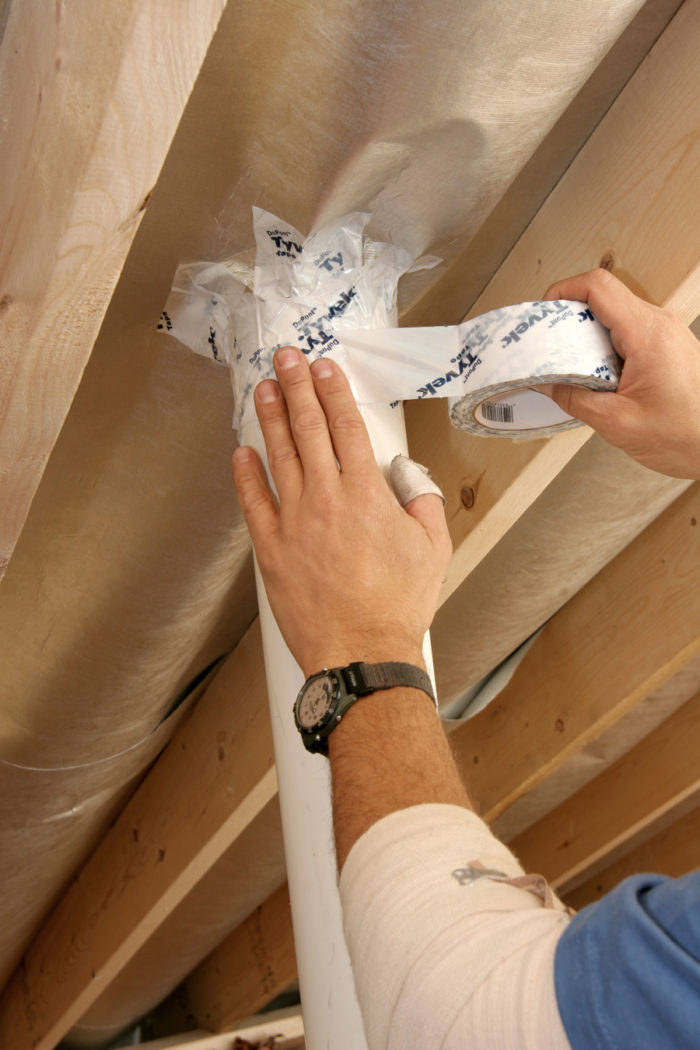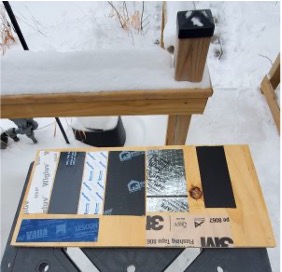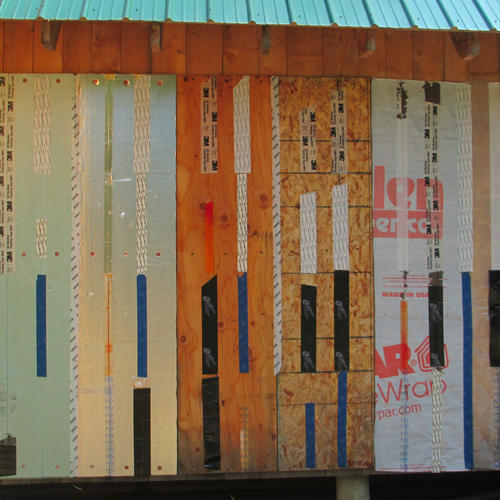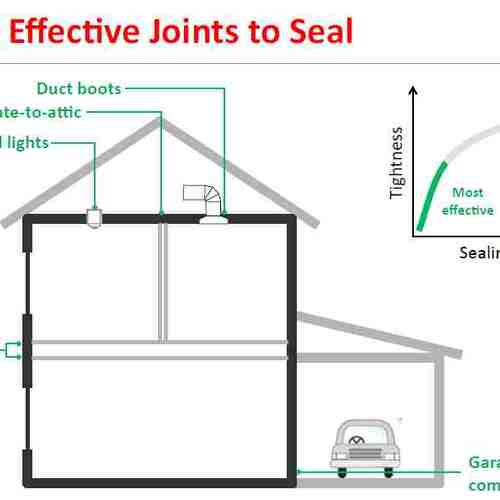
Image Credit: DuPont Tyvek
UPDATED March 8, 2013
After this article was published, Martin Holladay conducted a test of eleven air-sealing tapes on a variety of materials. To read the results of Holladay’s testing, see Backyard Tape Test and Return to the Backyard Tape Test.
It’s hard to create a tight air barrier without using tapes, gaskets, caulk, or spray foam. In this blog, I’ll look at two of these categories — tapes and gaskets. I’ll be focusing on air-sealing products, so I’ll ignore flexible flashing tapes used for waterproofing. (I’ll address duct sealing in a future blog.)
[Author’s note: since this blog was originally published, two U.S. distributors have begun selling high-quality European construction tapes. While these tapes tend to cost more than tapes from U.S. manufacturers, most builders who have tried them have been impressed with their performance. Moreover, European tape manufacturers (unlike U.S. manufacturers) offer tapes that are vapor-permeable. The two distributors are Small Planet Workshop of Olympia, Washington (distributor of several types of Siga tape, including Corvum, Rissan, Sicrall, and Wigluv tapes) and Four Seven Five of Brooklyn, New York (distributor of Contega tape, Tescon tape, Unitape, Rapidcell tape, and Budax Top tape).]
I’d like this blog to be a work in progress, so I strongly urge readers to post information on products that work well.
A multitude of tapes
To limit air leakage, builders use tapes to seal the seams of a variety of membranes and buildings products, including housewrap, polyethylene, OSB, and plywood. Tapes are also used to seal duct seams, to seal leaks around penetrations through air barriers — for example, to seal around plumbing vents — and to seal sheet goods to a variety of materials, including concrete.
Needless to say, no single tape works well in each of these…
Weekly Newsletter
Get building science and energy efficiency advice, plus special offers, in your inbox.

This article is only available to GBA Prime Members
Sign up for a free trial and get instant access to this article as well as GBA’s complete library of premium articles and construction details.
Start Free TrialAlready a member? Log in















35 Comments
Construction Adhesive?
I remember a framer at the JLC forum who proposed using construction adhesive between sheathing and framing in addition to the mechanical fasteneners.
I think his intention was structural enhancement not air control.
He was pretty well laughed at for "overkill"
I have often wondered about the air control quality of such a strategy?
Is the bond between sheathing/construction adhesive/framing backer reliable over time?
Rollie Peschon
Martin,
You mentioned Rollie in your blog.
I think he had one of THE best construction blogs I have seen.
http://imageevent.com/okoboji_images/deloreshouse;jsessionid=7iuejflor1.zebra_s?n=0&z=2&c=4&x=0&m=24&w=0&p=0
Using construction adhesive to stop air leaks
John,
As far as I know, construction adhesive is a good air-sealing product. It is certainly the most common way to seal the crack between subflooring and rim joists; without construction adhesive, this is a potential air leakage crack. (That's why it's important for construction adhesive under subfloors to be installed in a continuous ribbon rather than a series of interrupted dots -- at least at the perimeter of the floor.)
Gap Gasket
We've started using Cons. Tech's gap gasket in the past year. It seems to work well, and I like it both for its air sealing and also because it leaves a potential path for any leaks to make their way down to our window or door pans and escape.
recent observation about construction adhesive
I was removing an old door the other day and found the familiar brown construction adhesive was used between the entire vertical length of a 1x (used as the jamb stop) and a 2x (used as the door frame). The adhesive had turned very brittle and no longer had any holding power. When I pulled the boards away from each other the adhesive shattered into shards that fell to the floor. Hard for me to judge if something that turned so brittle but still trapped in place could serve as an air sealant.
A little context - door was on south exterior wall in a cold/very cold climate so has seen large temperature extremes. The door was probably around for 20-25 years.
Owens Corning Energy Complete
OC recently introduced an insulation system that incorporates a spray-on gasket system with either loose fill or batt insulation that appears to be a good solution to the air sealing problem. The gasket is sprayed on all gaps to be air sealed. It doesn't require the same level of personal protection as typical spray foam insulation; it expands minimally and compresses easily. I haven't seen any test results on the product yet.
Gaskets and Air Tight Electrical Boxes
We have been selling the Conservation Technologies drywall and sill gasket for quite sometime now and have had very good success with the product. We have blower door tested several projects that used the gaskets at any wood to wood connection and utilized the drywall gasket for air tight drywall. Most of these projects have very little urethane foam sprayed in them and are insulated with densepack cellulose in the walls. One of the projects tested out at .56 ACH50, and the others were at .89 ACH50, 1.1 ACH50, etc.... Another key to this is the use of the airtight electrical box and a foam gasket around the flange. We have tried both the Lessco Airtight boxes and the Air Foil boxes and have found that the Air Foil boxes are easier to install and more user friendly for the trades. Another issue we had with the Lessco box was that they tend to push out when using densepack cellulose in the wall cavities. You can see some examples of the boxes on our website @ http://energetechs.com/test-test-test/foam-sealing-products/electrical-boxes/
Agree re: Constr. Adhesive
I too would be hesitant to use construction adhesive as an air seal for the same reason. We've been using Cons. Tech's building gaskets under our walls and sills for a while and think they're a great product.
Polyether sealant for sheathing seams
From what I understand, polyether sealants have been used for a while in commercial construction to seal joints. Polyethers have a number of advantages over other sealants commonly available to residential builders. One company - York Manufacturing - recently started promoting a few polyether sealants for home construction.
I tried a couple products, GreatSeal LT-100 and GreatSeal PE-150 to seal seams in XPS and OSB with good success. A flare shaped attachment turns the round bead into a ribbon of sealant to coat seams efficiently without need to smear by hand. The sealants gun at low temperatures - much lower than you can effectively apply any self-adhering flashing tape. And according to the literature, have very low VOC content. Of course, like any other new product, the only way we'll know how it performs long-term is to wait 30 years and pull a few walls apart.
http://www.yorkmfg.com/all_sealants.asp
Air Sealant Tapes and Gaskets
Having been in the industry as a sealant and adhesive manufacturer for over 33 years now, I feel so sorry for the residentail builder and remodeler who is trying to sort out 1) what sealant or adhesive (caulk, gasket or tape) to use and 2) what is truly "green" in this era of significant greenwashing while standards what constitutes a sustainable product are still being identified in our small but important part of the industry. If leading commercial consultants are still sorting this out due to the rapdily increasing value and need of air and vapor barriers, must be hard for the residential contractor unless he shops at the knowledgeable specialty waterprofing distributors, or does a lot of careful research. First, very little sticks to polyethylene, it's used as a bond release in many applications. What was described by Martin Hallady as a solution for the Trenco Acoustical Sealant will work equally as well with any good quality sealant. As MIke Guetin points out, polyethers (a,k.a. hybrids, STP's or modified silicones) are used in commercial work, but in fact are still a very small part of that market, newer to these aplications, so I suggest also consider a good quality silicone or urethane depending on your application. Sealing around doors and windows, and for a redundant or secondary seal when using gaskets (they take compression sets also) these will give you the best air, vapor and WATERproof seal. Without question using peel and sticks for sealing sheet membranes is the best way to go there. I get my sealants at work for free, and yet bought rolls of Grace's product when residing sections of my cedar shingled house last year. As for construction adhesives, they've come a long way, but buy the right one and install in a continuous bead as several recommended if you're looking for them to double as an air seal. Realize all of them will be stiff when cured, so won't take much movement like a sealant as the materials they're adhered to expand and contract at differrent rates. So relying on them as both a glue and an air seal will be effective only when both materials, ie the wood to wood, or wood to concrete expand and contract at the same rate and when adhesion is great to both substrates. Want to elimiate a lot of these lap, seam and connection problems, consider a liquid air and vapor barrier such as Prosoco or Sto's, fast replacing sheet membranes in critical commerical applications. Had I resided my entire home, I would have eliminated many (not all), the various peel and sticks, sheet membranes, adhesives and sealants used to upgrade the performance of my 35 year old rotting barrier wall to a modified rain screen. But if I had, guess I would never apreciate first hand what a the pain in the neck you guys go through finding and using the products we make!
peril
I remember the rush in the '70s to Urea-formaldahyde insulation,carbon monoxide poisoning from wodburning stoves and to tight a seal and MOLD. Whatever the optimum solution, it's still important to insure fresh air exchanges.
Comparison to Foam
We'll be interested to see your comparison of these approaches vs going straight to spray foam. Performance, Cost, and Labor time advantages / disadvantages. We are advocates of using a single system, often open cell spray foam as a way to get the air sealing benefits rather than flash and bat or other techniques. In new builds we believe that there is a good performance and economic case for this - but would be interested to see 3rd party data. Air in a retrofit situation is another conversation as well.
Air sealing with tape, etc go
Air sealing with tape, etc go hand in hand with radiant barriers. I noticed the radiant barrier between the rafters in this graphic.
Ed Gilson Mfg rep
Two Comments/Questions
Great column, Martin. A few comments:
"For sealing the seams of foil-faced polyisocyanurate (for example, Thermax, Tuf-R, or Energy Shield), many builders prefer to use a foil-faced tape with an acrylic adhesive (for example, Venture 1520 or Venture 1521). Others use Dow Weathermate housewrap tape."
We've moved away from using foil tape in this application--admittedly, it wasn't Venture Tape, but off-the-shelf Home Depot foil tape. We knew it was a bad sign when the contractor said, "Yeah, it's great using this stuff... it comes right off the polyiso if you put it on wrong!" Uh oh... It also started to visibly come off the wall during construction. We ended up switching to Dow Weathermate tape, and have been pretty happy with the tack and adhesion.
"For sealing seams in crawl-space ground covers (and for sealing ground covers to concrete walls), some builders recommend the use of fiberglass mesh tape embedded in duct mastic."
Out of curiosity, why the fiberglass mesh tape? It makes sense to use it when mastic is spanning a crack, and needs some reinforcement to take the tensile loads (e.g., duct sealing across a gap). But attaching crawl space polyethylene to walls or penetrations is more of a matter of buttering both sides, and directly attaching them (e.g. plastic-to-plastic, or plastic to wall). Some pictures of my adventures with crawl space sealing here: http://www.flickr.com/photos/70684282@N00/sets/72157624663055242/
Thanks, Kohta
Kohta,
Thanks for your comments -- good stuff!
reply to Kohta Ueno
Just a little FYI - when I contacted Dow to get a data sheet of their tape they referred me to Venture Tape as the manufacturer.
New Energy Star standard says no to construction adhesive
My experience with construction adhesive is that it is a temporary measure for use while the building is going together. I'd advocate abandoning it as a sealant. EPA says construction adhesive is not to be considered a sealant.
In response to whether finicky air sealing details are more expensive than just spray foaming the house... Spray foam insulation doesn't go everywhere that air could leak. I've seen enough distessingly leaky spray foam houses to stand firmly on the side of a dedicated air barrier, apart from the insulation. Given the relative geometric simplicity of the exterior of a home compared to the interior, exterior air barrier systems like Huber Zip are looking very attractive. Get back to me in 50 years when we know how the tape is holding up.
Thermal Bypass
I'm double posting this one because I think it has relevance. I hope that the article found at the end of this link is of interest:
http://www.aecb.net/PDFs/Impact_of_thermal_bypass.pdf
Cheers
Mark
zip tape and cons. technology gaskets
I highly recommend using zip tape to seal gaps in plywood (prime first for better result). It's thinner and more pliable than vycor. I find vycor to be stiff and hard to get to stick in cold and wet condition.
I also use the gaskets from conservation technology and I'm very happy with them.
What kind of primer?
What are you guys who are taping OSB seams using? Is this just exterior paint-type primer or is there something specific for this application?
Primers for OSB
Jeff,
Here are two primers for OSB that I've heard good things about:
Tescon primer from Four Seven Five
Siga Dockskin primer from Small Planet Workshop
adhesives, tapes and primers
Wanted to add a few notes here regarding the pro clima products that we import with foursevenfive.com in relation ship to this post and disccusion:
Construction adhesive dry and become hard - once it is dry it will crack/em-brittle, especially when building elements expand/contract with temperature/humidity.
Acoustical sealant is not meant to be an airbarrier and use is thus off-label.
The OR-F adhesive is designed for make airtight connections - it doesn't dry - it remains sticky/flexible and can thus assure long term airtightness when connecting membranes to concrete. Some additional info about this and other airsealing junctions in our recent blogpost: http://foursevenfive.wordpress.com/2012/06/21/when-buildings-move-airtightness-should-last/
Regarding primers:
We have yet to find OSB that our tapes (TESCON Vana/No.1, UNITAPE) do not adhere well to without primer. Wiping oil residue off with mineral spirits can help make a better bond.
Other tapes do indeed benefit from the TESCON Primer RP we carry, or when you want to tape to cementitious materials (brick, concrete) etc.
Caulking/sealing at our house
We did some thermal imaging at our place last year after which we're now starting some retrofit work.
We has some great advice from GBA on how best to approach the thermal imaging. Perhaps some GBA folks could help us with advice on caulking and sealing. I have a contractor coming around tomorrow who I think is mainly familiar with caulking. The article above is food for thought as to the best sealing approach.
We identified several leaks. One major source of airflow is between the baltic pine boards in our floors. Perhaps these would be a good candidate for taping? We also appear to have significant leaks coming through our skirting boards in several places. What would be the best approach to sealing these? Taking them off and refitting them would be expensive. I guess gaskets around the electricity sockets?
Thanks
David
Response to David Coote
David,
You didn't explain whether the pine boards are your finish floor or your subfloor. In either case, if you have air infiltration through floor boards, the best solution is to remove the finish floor -- either temporarily or permanently, depending on the type of flooring -- and to install a layer of plywood subflooring.
If you have leaks at your baseboard (skirting boards), the usual solution is to caulk the gap between the baseboards and the flooring -- and in some cases the gap between the baseboard and the drywall or plaster. Use an inconspicuous caulk.
Gaskets don't do much on electrical boxes. The best solution on an electrical box: turn off the circuit breaker; remove the cover plate; caulk the back of the box where the wires penetrate the box; caulk the crack between the drywall and the box; replace the cover plate.
Thanks, Martin. I think the
Thanks, Martin. I think the boards are placed directly on the joists so this would constitute both the finish floor and subfloor, I guess. Twould be good to rip them off and replace with tighter boards but obviously a major expense as well as the inconvenience.
Would it be possible to cut plywood to fit between the joists and underneath the floorboards? This could give a nice seal? One problem would be in areas where the crawlspace is very tight. Perhaps we could roller something on there?
Or to use some tape on the underside of the boards to cover the cracks?
We could possibly caulk into the cracks from above with a dark caulk but I would be concerned about the caulk popping up from the cracks.
Response to David Coote
David,
If your floor consists of a single layer of boards, with air infiltration occurring between the boards, it's time for new flooring. I would install either a layer of building paper followed by new boards, or a thin layer of plywood followed by the finish flooring of your choice. That is likely to be the easiest solution.
If you want to try to solve the problem from the crawl space side, the classic solution would be two-component spray foam.
If you don't want to use spray foam, I suppose you could mess with rectangles of plywood or rigid foam between the joists. That's fussy work, though. I would use rectangles of rigid foam rather than plywood. You have to air-seal the edges of every single piece you install.
Thanks, Martin. There would
Thanks, Martin. There would be a lot of houses in Melbourne of similar vintage to ours (1930) which would have the same problem. A likely assumption made by the builders was that these houses would have wall-to-wall good quality wool carpet. The carpets would add some insulation and, of course, block airflow through the floorboard cracks. There's been a trend over the last 20 years or so to rip up the carpet, polish the boards and have these as the flooring. The boards do look spectacular once polished. Lovely rich caramels. But as the boards are now 80 years old or so they have cracked, the houses may have moved a bit - all that reactive/expansive clay! - opening up gaps between the boards and the boards may have been not well laid at construction time. And baltic pine is a soft timber and not well suited to high traffic use.
So replacing would be great but expensive and a pain.
The spray foam sounds like a good approach. Do rodents like to establish homes in the spray foam? Or is it too tough for them? I'm guessing southern hemisphere rattus rattus would show similar behaviour to their northern hemisphere forebears.
Response to David Coote
David,
I have heard of many problems with rodents in fiberglass batts, but not of rodents in spray foam.
Updated Info
Hi
This was a very informative article and discussion. Any chance that we could get an updated version...What are current experiences with tapes, sealants and gaskets?
We are currently reconsidering what products to spec for air sealing plates, sheathing, etc. and it would be great to know the current state of the industry and what seems to be performing better than others.
Updated Info
Also, it makes sense that gaskets work better than sealants. What product would be appropriate b/w the back face of sheathing and the side face of the sill plate and wall bottom plate?
Also, b/w underside of sheathing and top of rim?
Thanks
Response to Chris Harris
Chris,
You'll have to be patient for a few more weeks. The next issue of Fine Homebuilding will have my article on air sealing tapes. That article includes lots of new information.
Thanks
We all could use a little more patience...
Any info regarding sealants at sheathing/ plates overlaps? I assume you can use the same gasket products as you would be sill plates and floor sheathing....
Thanks
3M Sealing Tape 8777
Does anybody have any experience with 3M Sealing Tape 8777?
It's the closest we can get in Chile.
Response to Jose Castro
Jose,
If that is the only available tape, it sounds like a good choice. 3M is a reputable company, and the technical specifications sound good. Here is a link to a page with more information:
http://multimedia.3m.com/mws/media/740845O/3mtm-sealing-tape-8777.pdf?&fn=16158.pdf
Acrylic vs butyl...
butyl based tape like fortiflash butyl, or acrylic, like 3m 8067? For sealing plywood sheathing.
It seems any irregularities and protrusions in your plywood/nails, etc. will be better sealedby a thicker adhesive, like butyl, because it’ll “seep” into nooks and crannys better than an acrylic based tape which has a relatively thin adhesive layer.
Thoughts?
Log in or become a member to post a comment.
Sign up Log in